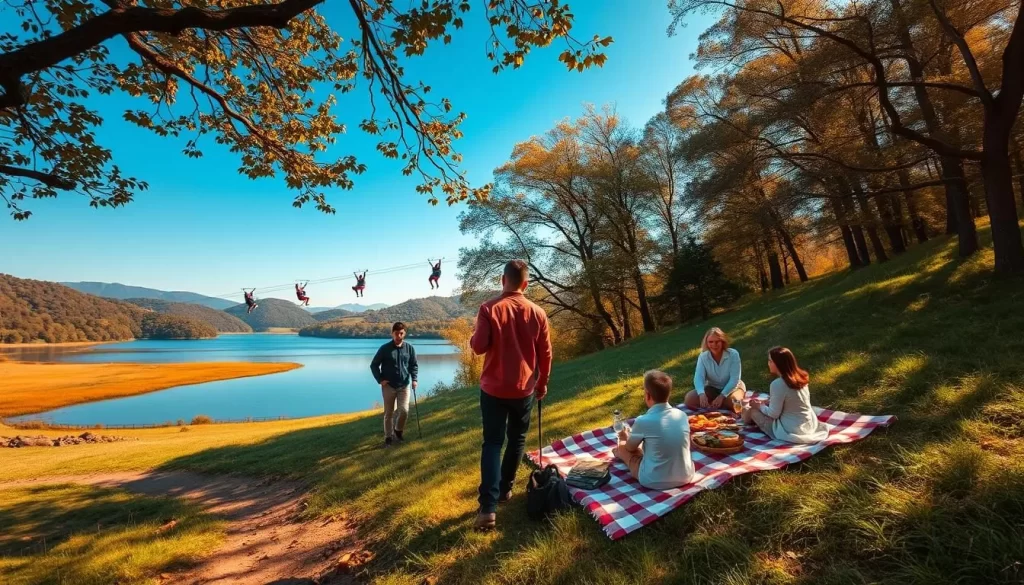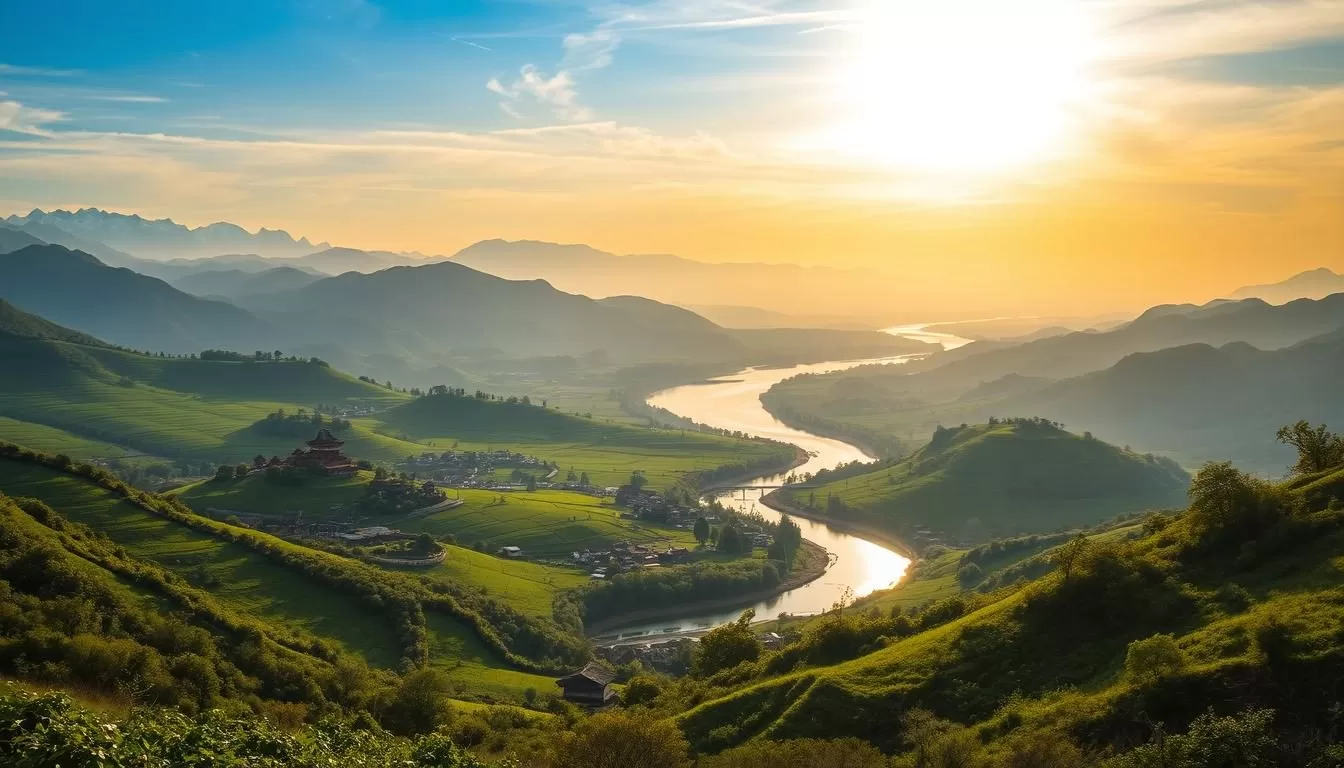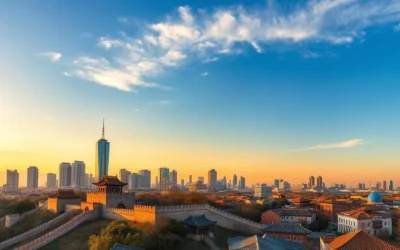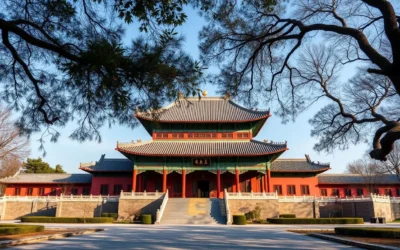✓ Accommodations✓ Flights✓ Rental Cars
Planning a trip to Henan? Understanding the best time to visit can make all the difference. This region offers a unique blend of cultural richness and natural beauty, but its weather patterns play a key role in shaping your experience.
Henan’s climate ranges from 51°F to 91°F, with distinct hot and cool seasons. This variation means you’ll need to plan carefully to enjoy outdoor activities and local festivals. For instance, the Luoyang Peony Festival, held from April 1 to May 7, is a must-see event that thrives in pleasant spring weather.
Whether you’re exploring ancient sites or enjoying vibrant night markets, the weather can influence your itinerary. Sunny days are perfect for sightseeing, while overcast periods might call for indoor attractions like the Luoyang Museum, which houses over 400,000 cultural relics.
Choosing the right time to visit China ensures a smoother and more enjoyable journey. With detailed weather data, you can tailor your trip to match your preferences and make the most of your adventure.
Welcome to Your Weather-Savvy Henan Adventure
Ready to explore a destination where culture meets comfort? Timing is everything when planning your trip. Spring and autumn are the best time visit for pleasant weather and fewer crowds.
These seasons offer ideal conditions for outdoor activities and cultural exploration. From blooming peonies to vibrant festivals, you’ll find plenty to enjoy. For instance, the Zhengzhou International Peony Festival in April is a must-see event.
Traveling during these periods ensures a smoother experience. You’ll avoid extreme temperatures and enjoy comfortable days for sightseeing. Whether you’re visiting the Shaolin Temple or the Longmen Grottoes, the weather will enhance your journey.
Planning your travel around these seasons also means fewer crowds. This allows you to fully immerse yourself in the local culture and natural beauty. Private tours and affordable attractions make it even more convenient.
By choosing the best time visit, you’ll create unforgettable memories. Let’s dive deeper into how these seasons can shape your adventure and make your trip truly special.
Overview of Henan Province Weather Patterns
Understanding the weather patterns in this region can help you plan a more enjoyable trip. The climate here varies significantly, offering unique experiences throughout the year. From warm summers to chilly winters, each season brings its own charm and challenges.
Temperature Trends
The average annual temperature ranges from 14°C to 16°C, making it suitable for various activities. In summer, temperatures can reach as high as 37°C, while winter temperatures can drop to around -10°C. These fluctuations mean you’ll need to pack accordingly and plan outdoor activities wisely.
Daily and hourly changes in temperature can also influence your travel plans. For instance, mornings might be cool, while afternoons can get quite warm. This variability ensures you’ll experience diverse conditions during your stay.
Rainfall and Cloud Cover Insights
Rainfall averages about 600 to 800 mm annually, with most occurring during the summer months. This means you’re more likely to encounter rain if you visit during this season. However, the number of rainy days varies, so it’s worth checking forecasts before your trip.
Cloud cover percentages also change throughout the year. Clear skies are more common in autumn, making it an ideal time for sightseeing. On the other hand, overcast days are frequent in summer, which might call for indoor activities.
| Season | Average Temperature (°C) | Rainfall (mm) |
|---|---|---|
| Spring | 14-20 | 150-200 |
| Summer | 25-37 | 300-400 |
| Autumn | 16-22 | 100-150 |
| Winter | -10-5 | 50-100 |
By understanding these patterns, you can choose the right time for outdoor activities and make the most of your trip. Whether you’re exploring historical sites or enjoying local festivals, the weather will play a key role in shaping your experience.
Henan Province, China: Best Months for a Weather-Savvy Trip
Timing your visit right can transform your travel experience. Choosing the correct month and day is crucial for a stress-free trip. Different periods offer unique benefits based on temperature, rainfall, and clear skies.
For instance, mid-October to late November is ideal for pleasant weather and fewer crowds. This time ensures comfortable days for exploring outdoor attractions and cultural sites.

Planning your trip around optimal conditions allows you to enjoy your visit fully. Understanding daily weather changes helps you adjust your schedule for outdoor activities.
Matching your itinerary with favorable conditions maximizes comfort. Whether you’re sightseeing or attending festivals, the right time enhances your journey.
By selecting the perfect month, you’ll create unforgettable memories. Make the most of your adventure by aligning your plans with the best weather conditions.
Seasonal Weather Breakdown
Exploring the distinct seasons can enhance your travel experience. Each season offers unique weather patterns that shape your activities and itinerary. Understanding these differences ensures you make the most of your trip.
Spring and Autumn Highlights
Spring (March to May) brings mild temperatures and blooming flowers, making it a favorite for visitors. The average temperature ranges from 14°C to 20°C, ideal for outdoor walks and sightseeing.
Autumn (September to November) features crisp, clear days with cooler temperatures. October, in particular, is perfect for exploring historical sites and attending local festivals.
Both seasons are known for their pleasant weather and vibrant events. Whether you’re strolling through gardens or attending cultural celebrations, these periods offer unforgettable experiences.
Summer and Winter Contrasts
Summer (June to August) can be intense, with temperatures reaching up to 37°C and high humidity levels. While it’s a great time for indoor activities like museum visits, outdoor exploration may require early mornings or evenings.
Winter (December to February) brings cooler air, with temperatures dropping to -1°C and occasional snowfall. This season is less ideal for tourism but offers a unique charm for those who enjoy quieter, serene landscapes.
Each season has its own appeal. By aligning your activities with the weather, you can create a trip that matches your preferences and ensures maximum comfort.
Understanding Optimal Travel Conditions
To make the most of your journey, understanding the optimal travel conditions is essential. These conditions are determined by factors like temperature, cloud cover, and precipitation, which together create the perfect environment for exploration.
Tourism scores indicate that the peak travel periods occur during shoulder seasons. These times offer ideal weather—neither too hot nor too cold—making them perfect for outdoor activities like hiking, sightseeing, and attending festivals.
Moderate precipitation and clear skies are key components of these conditions. They ensure that your plans aren’t disrupted by extreme weather, allowing you to enjoy every moment of your adventure.
Here’s how you can plan around these optimal conditions:
- Check weather forecasts to identify periods with mild temperatures and low rainfall.
- Schedule outdoor activities during the day when the weather is most comfortable.
- Pack layers to adapt to any minor changes in temperature.
By aligning your trip with these peak periods, you’ll avoid the discomfort of extreme heat or cold. This ensures a smoother, more enjoyable experience, whether you’re exploring nature or immersing yourself in local culture.
Understanding and planning for these conditions can transform your travel experience. It allows you to focus on creating unforgettable memories rather than worrying about the weather.
Heat and Cool Phases for Outdoor Activities
Discover how seasonal changes shape your outdoor adventures. Each season brings unique opportunities to explore and enjoy the outdoors. Whether you’re embracing the warmth of summer or the crisp air of winter, there’s something for everyone.
Summer Highlights: Embracing the Warmth
Summer is perfect for those who love long daylight hours and active days. Temperatures range from 25°C to 37°C, ideal for outdoor activities like hiking and sightseeing. The extended daylight allows you to make the most of every hour, whether you’re exploring nature or attending local events.
Wind patterns during this season are generally mild, making it easier to plan your outings. Early mornings and late evenings are cooler, providing a comfortable break from the midday heat.

Winter Wonders: Enjoying the Crisp Air
Winter offers a completely different yet equally enjoyable experience. With temperatures dropping to -1°C, the brisk air is perfect for serene walks and quiet exploration. The wind patterns during this season add a refreshing touch to your outdoor activities.
Hourly temperature variations mean you can plan your day around the most comfortable times. Mornings are crisp, while afternoons may feel slightly warmer, allowing for flexible scheduling.
| Season | Average Temperature (°C) | Wind Speed (km/h) |
|---|---|---|
| Summer | 25-37 | 10-15 |
| Winter | -1-5 | 15-20 |
By tailoring your itinerary to these climatic phases, you can enjoy a diverse range of experiences. Whether you’re basking in the summer sun or embracing winter’s chill, the weather adds a unique dimension to your adventure.
Monthly Temperature Analysis
Analyzing monthly temperature trends can help you plan a more comfortable and enjoyable trip. Understanding these patterns ensures you’re prepared for the weather, whether you’re exploring bustling cities or serene landscapes. Let’s dive into the details to make your journey smoother.
Average Highs and Lows
Monthly temperatures in this region vary significantly. In winter, lows can drop to -1°C, while summer highs reach up to 34°C. These extremes highlight the importance of choosing the right time visit for your activities.
Spring and autumn offer the most stable conditions, with averages between 15°C to 25°C. This period is ideal for outdoor exploration and cultural events. Packing layers ensures you’re ready for any minor changes.
Hourly Fluctuations
Hourly temperature changes can impact your daily schedule. Mornings are often cooler, while afternoons can be warmer, especially in summer. Planning outdoor activities for mid-morning or late afternoon ensures maximum comfort.
Understanding these fluctuations helps you structure your day efficiently. For example, visiting a city’s historical sites in the morning avoids the midday heat. Evening strolls are perfect for enjoying cooler temperatures.
| Month | Average High (°C) | Average Low (°C) |
|---|---|---|
| January | 5 | -1 |
| April | 20 | 10 |
| July | 34 | 25 |
| October | 22 | 12 |
By analyzing monthly and hourly trends, you can tailor your trip to the weather. This ensures a more enjoyable experience, whether you’re exploring a vibrant city or a tranquil countryside. Planning around stable periods maximizes comfort and convenience.
Managing Rainfall and Cloud Cover During Your Visit
Rainfall and cloud cover can significantly impact your travel plans, so understanding these factors is essential. These elements affect everything from scenic views to nighttime activities, making it crucial to plan accordingly.
In this region, rainfall averages 600 to 800 mm annually, with the wettest months being July and August. Cloud cover also varies, with winter months seeing up to 60% overcast skies compared to 30% in summer. These variations can influence your experience in different areas.
- Check weather forecasts to anticipate wet days and adjust your itinerary.
- Visit popular sites early in the day to avoid afternoon rain or overcast skies.
- Pack waterproof gear and plan indoor activities as backups.
Different areas may experience varying levels of precipitation. For instance, urban zones might have better drainage, while rural areas could be more affected by heavy rain. Knowing this helps you choose the right destinations based on the weather.
Nighttime conditions can also be unpredictable. Overcast skies might obscure starry views, but they can create a cozy atmosphere for evening strolls. Flexibility is key to enjoying your trip despite the weather.
| Season | Average Rainfall (mm) | Cloud Cover (%) |
|---|---|---|
| Spring | 150-200 | 40 |
| Summer | 300-400 | 30 |
| Autumn | 100-150 | 50 |
| Winter | 50-100 | 60 |
By understanding rainfall and cloud cover patterns, you can make informed decisions about your travel plans. This ensures you enjoy every moment, whether you’re exploring a scenic view or relaxing at a cozy site.
Dealing with Humidity and Wind Patterns
Weather conditions can make or break your travel experience, especially when humidity and wind come into play. These factors can significantly influence your comfort and plans, whether you’re exploring bustling cities or serene landscapes. Understanding how they interact ensures a smoother journey.
Humidity levels can vary widely across the region. In the north, summers are drier, while the south experiences higher humidity, especially during peak months. This difference can affect your outdoor activities, making it essential to plan accordingly.
Humidity Comfort Levels
High humidity can make warm days feel even hotter, impacting your energy levels and comfort. In the south, humidity often reaches 80% during summer, making it feel stifling. On the other hand, the north offers more moderate conditions, ideal for extended sightseeing.
Wind patterns also play a role in your travel experience. The north tends to have stronger gusts during spring and autumn, while the south experiences milder breezes. These variations can influence your choice of activities and timing.
Here are some practical tips to manage these conditions:
- Check real-time weather forecasting tools to plan your day around optimal conditions.
- Pack lightweight, breathable clothing for high humidity and layers for windy days.
- Schedule outdoor activities for early mornings or late afternoons to avoid peak heat and humidity.
When visiting tourist hotspots, these weather factors can modify your expectations. For instance, windy days might make outdoor photography challenging, while high humidity could shorten your time exploring open areas.
| Area | Average Humidity (%) | Wind Speed (km/h) |
|---|---|---|
| North | 50-60 | 15-20 |
| South | 70-80 | 10-15 |
By preparing for these conditions, you can ensure a more enjoyable trip. Whether you’re in the north or south, understanding humidity and wind patterns helps you make the most of your adventure.
Tailoring Your Itinerary to the Weather
Adjusting your plans to match the weather can elevate your travel experience. By aligning your schedule with daily forecasts, you can make the most of your visit to historical sites and outdoor attractions. This approach ensures you’re prepared for any unexpected changes, allowing for a smoother and more enjoyable journey.
Customizing for Outdoor Activities
When planning your itinerary, consider the place and its unique weather patterns. For instance, mild temperatures in April and October make these months ideal for exploring outdoor attractions. Checking weather scores can help you decide the best time visit china for activities like hiking or sightseeing.
Here are some tips to customize your plans:
- Use daily forecasts to prioritize outdoor activities on sunny days.
- Visit historical sites early in the day to avoid afternoon heat or rain.
- Keep flexible options for indoor attractions in case of sudden weather changes.
Choosing the right place at the right time can deepen your appreciation for the region’s rich history. For example, visiting the Shaolin Temple on a clear day enhances the experience, while rainy days are perfect for museums.
Rearranging your schedule when conditions change is essential. If rain interrupts your plans, consider exploring local markets or cultural centers. This flexibility ensures you make the most of your time visit china, regardless of the weather.
Integrating outdoor activities with visits to historical sites creates a balanced itinerary. For instance, combine a morning hike with an afternoon tour of ancient ruins. This approach maximizes your experience and keeps your trip dynamic.
A well-tailored itinerary leads to a more immersive and enjoyable travel experience. By planning around the weather, you can fully appreciate the region’s history and natural beauty. For personalized advice, consider consulting travel experts who can help optimize your plans.
Seasonal Attractions and Events in Henan
Exploring seasonal attractions and events can add depth to your travel experience. Each season offers unique opportunities to immerse yourself in culture, history, and natural beauty. From vibrant festivals to stunning historical landmarks, there’s something for everyone to enjoy.
Cultural Festivals and Historical Sites
One of the highlights of visiting this region is its rich cultural festivals. The Luoyang Peony Festival, held from April 1 to May 7, showcases thousands of blooming peonies and attracts visitors from around the world. This event is a perfect blend of natural beauty and cultural heritage.
Historical sites like the Great Wall and the Forbidden City also play a significant role in enriching your journey. These landmarks offer a glimpse into the region’s storied past and are best explored during mild weather months.
Winter brings its own charm with attractions featuring snow and ice snow displays. These unique experiences transform the landscape into a winter wonderland, offering a fresh perspective on sightseeing.
Here are some tips to make the most of your visit:
- Plan your trip around major festivals like the Luoyang Peony Festival for a vibrant cultural experience.
- Visit historical sites early in the day to avoid crowds and enjoy cooler temperatures.
- Don’t miss winter attractions, which offer a unique twist on traditional sightseeing.
By timing your visit to coincide with these events, you’ll create unforgettable memories. For more insights into seasonal trends, check out this detailed guide on cultural celebrations.
| Season | Key Attractions | Best Time to Visit |
|---|---|---|
| Spring | Luoyang Peony Festival | April to May |
| Summer | Historical Landmarks | June to August |
| Autumn | Cultural Festivals | September to November |
| Winter | Snow and Ice Displays | December to February |
Whether you’re drawn to cultural festivals or historical sites, this region offers a wealth of experiences. Plan your trip wisely to enjoy the best of what each season has to offer.
Utilizing Travel Score Tools for Weather Insights
Travel score tools are your secret weapon for planning a weather-smart trip. These tools calculate composite ratings based on temperature, cloud cover, and precipitation to identify the best time year for various activities. By analyzing these factors, you can make informed decisions about when to visit and what to expect during your stay.

Understanding how these tools work is key to maximizing your travel experience. They break down weather data into easy-to-read scores, helping you determine the ideal week for outdoor adventures or indoor explorations. For example, a high tourism score indicates pleasant weather, while a low score might suggest rain or extreme temperatures.
Understanding Tourism and Beach/Pool Scores
Tourism scores are particularly useful for identifying the best time year for sightseeing and cultural activities. These scores consider factors like temperature and cloud cover to ensure comfortable conditions. Similarly, beach and pool scores focus on warmth and sunshine, making them ideal for planning water-based activities.
Here’s how these scores can simplify your planning:
- Use tourism scores to schedule visits to historical sites and festivals.
- Check beach/pool scores for sunny days perfect for outdoor relaxation.
- Monitor weekly trends to adjust your itinerary based on real-time weather updates.
These tools have been instrumental in identifying ideal visiting periods. For instance, they’ve highlighted April and October as the best time year for outdoor activities due to mild temperatures and clear skies.
| Score Type | Key Factors | Best Use |
|---|---|---|
| Tourism Score | Temperature, Cloud Cover | Sightseeing, Festivals |
| Beach/Pool Score | Sunshine, Warmth | Water Activities |
By leveraging these insights, you can simplify your decision-making process and create a weather-smart itinerary. For more detailed guidance, explore this resource on travel score tools to optimize your plans.
Travel score tools are more than just data points—they’re practical guides that ensure your trip is enjoyable and stress-free. Whether you’re planning for a specific week or the entire year, these tools provide the clarity you need to make the most of your adventure.
Comparing Henan’s Climate to Other Chinese Regions
Understanding how regional climates differ can help you plan a more informed trip. Weather conditions in this area vary significantly compared to other parts of the country, such as south China. These differences can greatly influence your travel plans, especially if you’re visiting multiple regions.
One key distinction is the frequency of rain. While this area experiences moderate rainfall, south China often sees heavier and more consistent precipitation. This can affect outdoor activities, so packing waterproof gear is essential for trips to the southern regions.
Temperature trends also vary. In the April May timeframe, this area enjoys mild weather, making it ideal for sightseeing. In contrast, south China can be warmer and more humid during these months. Planning your itinerary around these differences ensures a more comfortable experience.
Winter conditions are another factor to consider. While this area experiences cooler temperatures, regions like Harbin are famous for their ice snow displays. These unique phenomena create a winter wonderland, offering a completely different travel experience.
Here’s how these variations can inform your travel decisions:
- Choose April May for mild weather and fewer crowds in this area.
- Prepare for rain if visiting south China during the same period.
- Include Harbin in your winter itinerary to experience its iconic ice snow attractions.
By understanding these regional differences, you can tailor your trip to match your preferences. Whether you’re exploring this area or venturing to south China, planning around the climate ensures a smoother and more enjoyable journey.
What to Pack for a Weather-Smart Trip
Packing smartly can make your trip more enjoyable and stress-free. The weather here varies significantly throughout the year, so versatility is key. From hot summers to chilly winters, having the right gear ensures you’re prepared for any condition.
Here’s a breakdown of essential items to pack based on the time year you’re visiting:
- Spring and Autumn: Light layers, a waterproof jacket, and comfortable walking shoes. These seasons are mild but can have sudden rain showers.
- Summer: Breathable clothing, sunscreen, and a wide-brimmed hat. Temperatures can soar, so staying cool is essential.
- Winter: Thermal layers, a heavy coat, and insulated boots. Snow and wind can make it feel colder than the actual temperature.
Comparing packing needs to cities like Hong Kong can offer additional insights. While both regions experience humidity, the weather here is more varied, requiring a broader range of clothing.
Proper gear ensures comfort, whether you’re facing a hot, humid day or a chilly, overcast night. Packing smartly means anticipating changes and being ready for anything. For more tips on planning your trip, check out this guide.
| Season | Essential Items |
|---|---|
| Spring | Light layers, waterproof jacket |
| Summer | Breathable clothing, sunscreen |
| Autumn | Light layers, walking shoes |
| Winter | Thermal layers, heavy coat |
By tailoring your packing list to the year-round weather, you’ll stay comfortable and focused on enjoying your trip. Remember, the right preparation makes all the difference.
Practical Scheduling Tips for Your Visit
Crafting a well-planned schedule can make your trip more enjoyable and stress-free. By avoiding peak crowds and tailoring your plans to favorable weather, you can significantly enhance your sightseeing experience. Whether you’re exploring bustling cities or serene landscapes, these tips will help you make the most of your journey.
How to Avoid Peak Crowds
Timing is everything when it comes to avoiding crowds. Visiting popular attractions early in the morning or late in the afternoon can help you enjoy a quieter experience. Planning your trip throughout the year also allows you to choose less busy periods, especially in regions like north China, where weather patterns vary significantly.
Here are some strategies to minimize crowds:
- Visit major attractions on weekdays instead of weekends.
- Check local event calendars to avoid overlapping with festivals or holidays.
- Use online booking systems to secure tickets in advance and skip long lines.

Maximizing Comfort and Sightseeing
To ensure a comfortable trip, align your schedule with the weather. In north China, spring and autumn offer mild temperatures, making them ideal for outdoor activities. Summer can be hot, so plan indoor visits during midday, while winter requires warm clothing for outdoor exploration.
Here’s how to balance sightseeing and relaxation:
- Start your day early to take advantage of cooler mornings.
- Include breaks in your itinerary to rest and recharge.
- Use weather forecasts to adjust your plans and avoid unexpected rain or heat.
By planning throughout the year, you can show the best attractions without being overwhelmed by crowds. For more insights into creating a balanced schedule, explore this detailed guide on travel planning.
| Season | Best Time to Visit | Tips |
|---|---|---|
| Spring | Early morning | Enjoy blooming flowers and mild weather. |
| Summer | Late afternoon | Avoid midday heat by visiting indoor attractions. |
| Autumn | Mid-morning | Explore historical sites with fewer crowds. |
| Winter | Midday | Bundle up for outdoor activities in crisp air. |
Conclusion
Planning your trip with weather insights ensures a seamless and enjoyable experience. By understanding temperature trends, rainfall patterns, and seasonal highlights, you can make informed decisions about when to visit. Travel score tools are invaluable for identifying optimal periods, helping you avoid extreme conditions and maximize comfort.
Tailoring your itinerary to the weather allows you to explore outdoor attractions and cultural sites at their best. From mild spring days to crisp autumn afternoons, each season offers unique opportunities. Scheduling wisely also helps you avoid peak crowds, ensuring a more relaxed and immersive journey.
Consider this guide a reliable resource for planning your visit. If you need further assistance, professional travel services can provide personalized support to enhance your trip. A well-planned adventure leads to unforgettable memories and a stress-free experience.
For more insights into must-see attractions, check out this detailed guide on exploring the region’s rich history and vibrant culture.
The above is subject to change.
Check back often to TRAVEL.COM for the latest travel tips and deals.






